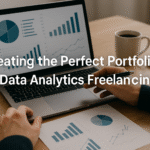Introduction to Freelancing in Data Analytics
The Rise of the Gig Economy
The gig economy has taken the professional world by storm. From graphic design to software development, professionals across every industry are leaving their 9-to-5s for more flexible, freelance lifestyles. Among these rising stars are data analytics freelancers—experts who dig deep into numbers to uncover trends, insights, and actionable strategies.
But here’s the catch: while the gig economy is booming, competition is fierce. It’s no longer enough to just be good at what you do—you need to know how to sell it. Clients aren’t going to throw money at you just because you can analyze a spreadsheet. They need results, and they need to trust that you are the one who can deliver them. That’s why finding high-paying clients is part skill, part strategy.
You’re not just a freelancer. You’re a business.
And businesses need customers—specifically, high-value customers who understand your worth. If you’re tired of low-ball offers or gig platforms that squeeze your rates to the bone, this guide will walk you through a better way. From building authority to attracting premium clients, it’s time to learn how to really make money in data analytics freelancing.
Why Data Analytics is in High Demand
Let’s face it—every business today is drowning in data. But having data is one thing; making sense of it is something entirely different. That’s where you, the data analyst, come in.
Whether it’s e-commerce companies trying to improve conversion rates, startups tracking user behavior, or Fortune 500 companies optimizing supply chains—data is the secret weapon behind smarter decisions. The need for data-driven insights is universal, which means your skills are more valuable than ever before.
Here’s the golden nugget: businesses don’t just want reports. They want solutions. If you can present your analytics in a way that drives decision-making and profits, you become a partner, not just a contractor. And partners get paid more—much more.
So, how do you make sure the right clients find you? Or better yet, how do you find them first?
Let’s dig in.
Building a Strong Foundation
Niche Down: Find Your Area of Expertise
One of the biggest mistakes data analytics freelancers make is trying to be everything to everyone. Sure, you might know SQL, Python, Power BI, Tableau, and even a bit of machine learning—but clients aren’t looking for generalists. They’re looking for specialists who solve specific problems.
Ask yourself: What kind of businesses do I want to work with? What data problems excite me the most? Do I love e-commerce analytics, SaaS product analytics, marketing funnels, or financial forecasting?
The clearer you are about your niche, the easier it is to attract the right clients. You’ll stand out more when your message is hyper-targeted. For example, “I help Shopify store owners double their revenue through predictive analytics” is way more compelling than “I offer general data analysis.”
Benefits of niching down:
- Easier to become a thought leader
- Less competition
- Higher perceived value
- More referrals within the same industry
Clients pay more for someone who knows their industry inside-out. Become that someone.
Create a Powerful Portfolio
Your portfolio is your proof. It’s the difference between “I can do that” and “I’ve done that.” And trust me, clients want proof.
A strong portfolio should show:
- Real-world results from your work
- Visuals like dashboards or data visualizations
- Problem–solution–result breakdowns
- Testimonials, if available
If you’re just starting out and don’t have paid client work, that’s okay. Build mock projects. Analyze public datasets. Create case studies based on hypothetical business scenarios. The key is to demonstrate your thinking, your skills, and your value.
Think about it—would you hire a contractor without seeing their previous work? Neither would your client.
Your portfolio is the backbone of your sales pitch, so give it the attention it deserves.
Build a Personal Brand That Sells
Here’s something nobody tells you early on: your personal brand is your client magnet. It’s what people say about you when you’re not in the room—and it’s what potential clients see when they Google your name.
To build a brand that attracts high-paying clients:
- Define your value proposition. What do you do, who do you help, and what makes you unique?
- Share content on platforms like LinkedIn, Medium, or X (formerly Twitter). Talk about data problems, insights, trends, and your experiences.
- Be consistent. Post regularly and engage with your audience.
- Show your face. Use a professional photo. Record short videos. Be human.
The truth is, people buy from people they trust. And trust is built through visibility and authenticity. By showing up online and providing value, you’ll start to build a name for yourself—and high-ticket clients do notice.
Optimizing Your Online Presence
Setting Up a Professional Website
In today’s digital world, if you don’t have a website, you basically don’t exist. Your website is your home base. It’s where potential clients land when they want to know who you are, what you offer, and whether they can trust you with their data.
But not just any website will do. You need a clean, professional, and conversion-focused site that communicates your value fast.
Here’s what your website must include:
- Home Page: Who you are, what you do, and the main benefit clients get from working with you.
- About Page: A personal, authentic story that highlights your expertise and passion for data.
- Services Page: Clearly outline what you offer, who it’s for, and how it solves real problems.
- Portfolio/Case Studies: Real examples of your work, with visuals and results.
- Testimonials: Social proof is powerful—include client quotes if you have them.
- Contact Page: Make it ridiculously easy to get in touch with you.
Bonus tip: Add a blog to share your knowledge. Write about the problems you solve, tools you use, and industry trends. This builds authority and improves your SEO, which helps clients find you organically.
A great website doesn’t just look good—it sells you before you ever say a word.
Leveraging LinkedIn for Networking
LinkedIn is more than just a digital resume—it’s a goldmine for connecting with decision-makers, especially in industries that are heavily reliant on data. If you’re not using LinkedIn to its full potential, you’re leaving serious money on the table.
Here’s how to optimize your profile:
- Headline: Clearly state who you help and what you do. Example: “Helping SaaS companies uncover growth opportunities through advanced data analytics.”
- About Section: Tell your story. Be human, but highlight your skills and how you bring value.
- Experience: Detail your roles and accomplishments. Focus on outcomes.
- Skills & Endorsements: List your top analytics tools and soft skills.
- Recommendations: Ask past colleagues or clients to write a short review.
But here’s the key: don’t just build a profile—be active. Post 2–3 times a week. Share insights, case studies, or useful tips. Comment on posts. Join relevant groups.
Engagement builds visibility, and visibility builds trust. And when decision-makers see you consistently showing up and adding value, guess who they’ll think of when they need a data analyst?
Yup—you.
Using Freelance Marketplaces Effectively
Freelance platforms like Upwork, Toptal, Freelancer, and Fiverr Pro are often misunderstood. Many freelancers see them as low-paying and overly competitive, but they can actually be a stepping stone to finding premium clients—if you play it right.
Here’s how to stand out:
- Craft a killer profile: Focus on results, not just skills. Use client-focused language.
- Choose a niche category: Don’t just be a “Data Analyst”—be the “E-commerce Conversion Data Expert.”
- Write custom proposals: Never send copy-paste pitches. Address the client’s specific problem, mention their company, and offer a quick insight or suggestion.
- Build initial trust: Take on a few smaller jobs to build up reviews and ratings. Then raise your rates as your reputation grows.
And don’t be afraid to graduate clients off the platform once trust is established. Many freelancers land multi-thousand-dollar ongoing contracts after just one small gig. It’s all about showing value fast and building relationships.
Strategies to Attract High-Paying Clients
Cold Outreach That Works
Most freelancers shy away from cold outreach because it feels awkward or spammy. But when done right, cold outreach is one of the most effective ways to land high-paying clients—especially in B2B.
Start by identifying your ideal clients. Look for:
- Startups with funding
- Mid-size companies with a data-driven culture
- Agencies that need white-label analytics support
Once you’ve got your list, craft a personalized message. Keep it short, friendly, and valuable.
Here’s a simple framework:
- Personalize the opening: Mention something specific about their company.
- Identify a problem: Point out a potential data challenge they might be facing.
- Offer a solution: Briefly mention how you can help.
- Include a soft call-to-action: “Would you be open to a quick call next week?”
Example:
Hey [Name],
I’ve been following [Company] and really admire how you’re expanding into new markets. I noticed your product data might be ripe for some deeper user segmentation—have you considered advanced cohort analysis to boost retention?
I help SaaS companies uncover hidden insights in their product data. Happy to share a few ideas if you’re open to it.
Best, [Your Name]
It’s not spammy. It’s value-driven. And it works—because you’re making it about them, not you.
Warm Leads Through Referrals and Networking
While cold outreach is powerful, nothing beats warm leads. These come from referrals, introductions, or people who already know and trust your work.
To generate more warm leads:
- Ask for referrals after every project.
- Join online communities like Reddit, Slack groups, and forums where your target audience hangs out.
- Attend in-person or virtual events in your industry.
- Collaborate with other freelancers or agencies who serve similar clients.
You’d be surprised how often a simple message like “Hey, do you know anyone who might need a data analyst?” can lead to an introduction.
Referrals often skip the sales process entirely. You’re coming in with trust already built—and that makes closing the deal much easier.
Positioning Yourself as a Premium Freelancer
Set Your Rates Based on Value, Not Time
If you’re charging by the hour, stop. Right now.
High-paying clients don’t care how long it takes you to do the work—they care about the outcome. And when you charge based on value, not time, you shift from being a commodity to becoming an investment.
Let’s break it down.
Say you help a Shopify store increase revenue by $50,000/month through better data visualization and funnel optimization. Do you think they care if you spent 10 hours or 30? No—they care that your work led to $600,000/year in new income. That’s the value.
So, instead of billing $50/hour, you could charge a flat fee of $5,000 for a full analytics audit and setup—and the client would happily pay it.
Here’s how to set value-based pricing:
- Understand the client’s business goals.
- Quantify how your work contributes to those goals.
- Present your fee as a fraction of the value delivered.
You’re not just selling dashboards or reports—you’re selling clarity, growth, and profitability. Charge accordingly.
Bonus tip: Offer tiered pricing packages (e.g., Basic, Pro, and VIP) to let clients choose the level of support they need. This puts you in control while giving them options.
Value-based pricing is how you break out of the $20/hour grind and start landing $10K+ contracts.
Use Testimonials and Case Studies
Social proof is a game-changer. Testimonials and case studies do more than brag on your behalf—they reduce doubt and build trust.
Clients want to know:
- Have you done this before?
- Did it work?
- What kind of results can I expect?
That’s why case studies are so powerful. They tell a story: Here’s the problem, here’s what I did, and here’s what happened.
How to write a compelling case study:
- Start with the client’s problem.
- Explain your approach and tools used.
- Highlight measurable results.
- Include a client quote or testimonial.
Even if you don’t have big-name clients, small wins are still wins. Helped a startup increase customer retention by 20%? That’s huge. Got a client’s churn rate under 5%? Brag about it—with numbers.
Sprinkle testimonials throughout your website, LinkedIn, proposals, and email signature. Let others vouch for your skills—because in the eyes of new clients, what others say about you often carries more weight than what you say.
Offer Specialized Services or Packages
High-paying clients don’t want vague “data analysis.” They want specific outcomes. That’s where specialized service packages come in.
Instead of saying “I do data analytics,” create branded offerings like:
- E-commerce Growth Dashboard Package
- Churn Reduction Audit for SaaS
- Marketing Funnel Optimization Analytics
- Predictive Sales Forecasting Tool
These types of packages do three things:
- Clarify what you do for clients (no guessing).
- Communicate value instantly.
- Make your services easier to price and sell.
Think of it like a menu. When you walk into a restaurant, you don’t want the chef to ask, “So… what do you feel like?” You want a menu of curated, delicious choices. Do the same for your services.
Package benefits:
- Saves time writing custom proposals
- Attracts ideal clients faster
- Makes you look more professional and experienced
When your offerings are productized, clients see you as an expert—not a jack-of-all-trades. And experts get paid better. Period.
Conclusion: The Path to Premium Clients Starts with Positioning
Finding high-paying clients as a data analytics freelancer isn’t about luck—it’s about clarity, value, and strategy. If you treat freelancing like a business (because it is), the results will follow. You’ve got the skills. You know the tools. Now it’s about packaging that expertise in a way that attracts serious clients with serious budgets.
Remember, premium clients aren’t looking for a freelancer—they’re looking for a partner. Someone who understands their business problems and can translate messy data into sharp, profitable decisions.
Here’s your action plan in a nutshell:
- Get crystal clear on your niche.
- Build an impressive, results-driven portfolio.
- Create a brand and online presence that shows authority.
- Be proactive—reach out, network, and share your knowledge.
- Price based on outcomes, not hours.
- Offer productized services that solve specific problems.
You don’t need hundreds of clients—you just need the right ones.
So go get them.
Frequently Asked Questions
1. What’s the best niche in data analytics for freelancers?
There’s no one-size-fits-all answer, but profitable niches include e-commerce analytics, marketing analytics, SaaS product analytics, and financial forecasting. Choose one that aligns with your interests, skills, and where demand is high.
2. How do I land my first high-paying client?
Start by optimizing your portfolio and LinkedIn profile. Do outreach to targeted companies with a clear, valuable message. Consider offering a small paid audit or consultation to get your foot in the door—then upsell once trust is built.
3. Do I need certifications to charge premium rates?
Certifications can help, especially early on, but they aren’t mandatory. Real-world results, solid case studies, and clear communication skills matter far more than a badge or credential in the eyes of clients.
4. What’s better: freelance marketplaces or direct outreach?
Both have their place. Freelance marketplaces can be great for building reviews and getting initial traction. But for premium clients and bigger budgets, direct outreach and referrals tend to be more effective long-term.
5. How do I know if I’m charging too little?
If clients rarely negotiate or say yes too quickly, you’re probably undercharging. Also, if you’re working a lot but not hitting your income goals, it’s a clear sign you need to raise your rates and focus on value-based pricing.



